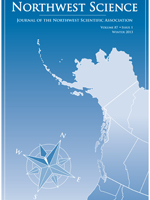Microclimate variables such as air temperature and relative humidity influence habitat conditions and ecological processes in riparian forests. The increased relative humidity levels within riparian areas are essential for many plant and wildlife species. Information about relative humidity patterns within riparian areas and adjacent uplands are necessary for the prescription of effective buffer widths. Relative humidity monitoring is more expensive than temperature monitoring due to greater sensor costs, and it is primarily conducted for research purposes. To make relative humidity monitoring in riparian areas more cost effective, we explored modeling relative humidity as a function of air temperature and other covariates using linear fixed and linear mixed effects models applied to two case studies. Localizing predictions for stream reaches using a linear mixed effects model or a linear fixed effects model with correction factor improved model predictions, especially when large variability among stream reaches was present. A minimum of three to five relative humidity measurements per stream reach seem sufficient to estimate the random stream reach effect or correction factor for the linear mixed and linear fixed effects models, respectively. Including covariates that describe distance to stream and canopy cover in addition to air temperature improved model performance. Although further model refinement is probably needed to allow detection of small changes in relative humidity associated with changes in stand structure from partial overstory removal, the models developed provide a means towards decreasing the costs of monitoring microclimates of importance to riparian area function.
How to translate text using browser tools
1 January 2013
Modeling Relative Humidity in Headwater Forests using Correlation with Air Temperature
Bianca N. I. Eskelson,
Paul D. Anderson,
Hailemariam Temesgen
ACCESS THE FULL ARTICLE

Northwest Science
Vol. 87 • No. 1
January 2013
Vol. 87 • No. 1
January 2013
linear mixed effects model
localized prediction
Pacific Northwest
riparian microclimate
subsampling




